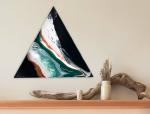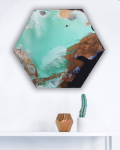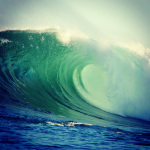B.L. Bruce's Blog, page 9
July 14, 2017
A Visit to the California Academy of Sciences (Broken Wagon Films’ “The Devil’s Road”)
So what does the California Academy of Sciences in San Francisco, California have in common with Nelson and Goldman and our documentary film, The Devil’s Road? Aside from the obvious scientific research and the institution’s exploration of our natural world, the connection was formed on a fortuitous day in 1905. Nelson noted in his 1921 book Lower California and It’s Natural Resources that he “reached Ensenada on July 5th and found the schooner Academy, from San Francisco, in port on it’s way to the Galapagos Islands with a scientific expedition from the California Academy of Sciences.” Nelson had several weeks’ worth of specimens that he and Goldman had collected from northern Baja, and needed to have them shipped to Washington D.C. The crew of the Academy welcomed Nelson aboard, agreeing to stow his cargo, and Nelson enjoyed a fine supper aboard the vessel.
On July 11, 2017, our film crew had the honor of conducting an interview with several of the California Academy of Sciences research specialists. We were met at the back door of the Academy by Katie Jewett of the Press Office. She would accompany us during our tour of the Department of Ornithology and Mammalogy. In the basement of the museum we entered the climate controlled room full of specimen collections. Maureen “Moe” Flannery, the Collections Manager has been put in charge of the hundreds of thousands of bird and mammal specimens and introduced us to several specimens that Nelson and Goldman collected over one hundred years ago.
The first specimen was a Mexican cormorant that was collected in 1902 by Nelson and Goldman. The bird was incredibly well preserved. Next, we were shown specimens of seaside sparrows. The particular specimen that Nelson and Goldman procured was collected in 1874 in Washington D.C. and was donated to the Academy many years ago. The last specimen was a Bailey’s pocket mouse, collected by Nelson and Goldman in December 1905 from a location just south of La Paz, Baja California Sur.
[image error]A well-preserved Mexican cormorant. Note the tag states “Nelson & Goldman.”
[image error]Seaside sparrow specimens, several of which were collected by Nelson & Goldman in 1874.
[image error]Maureen “More” Flannery, collections manager at the California Academy of Sciences, shows us the seaside sparrow specimens.
[image error]Bailey’s pocket mouse specimens.
Jack Dumbacher, Curator of the Ornithology and Mammalogy Department, rounded off the morning with a well-presented perspective of what naturalists like Nelson and Goldman’s fieldwork would have been like. He explained how they would have collected, preserved, and organized their specimens during an expedition. We also learned how valuable these specimens are to science. These thousands of study skins and mounts provide a glimpse into the past, how and where these animals lived, and even what they were feeding on when they were collected. As technology and new research methods change, their value will certainly increase over the next century and beyond.
[image error]Interview with Jack Dumbacher, Curator, Ornithology and Mammology Department
We would like to thank the California Academy of Sciences for their continued support of Nelson and Goldman’s work and of our film.


June 19, 2017
Original Artwork by Saltwater Studios
[image error] Announcing original artwork by Saltwater Studios!
Ocean-inspired abstract acrylic.
Original and commissioned pieces available on Etsy.



Saltwater Studios is an affiliate of Bri Bruce Productions.
*


Tea Tins!
Thanks for the mention! Happy to help with any design needs.
A while ago, a fellow author told me about this site where you can make custom tea blends and that they were a great idea to help promote your book. (See her blog post here: https://marciamearawrites.com/2015/06/19/promo-ideas-for-signings-attention-tea-lovers/)
I, too, thought it was a great idea, so I filed it in my mental database. Several years later, I finally got around to creating my own tea blend from Adagio Teas.
First, I needed some art for the tea tins I was going to use as promotion giveaways at book signings and the like. I was at loose ends on how to make/get a design for said tea tin. Honestly, the process was overwhelming–scrolling through DeviantArt left me with a huge wish list for all the art I want to buy when I attain my maybe-someday rich-and-famous status, but no tea tin art. I got equally as lost in trying to…
View original post 538 more words


June 14, 2017
STOCK PHOTOGRAPHY NOW AVAILABLE
Pleased to announce the addition of stock photography for personal and general licensing in BBP’s Etsy shop!







June 2, 2017
“THE HEIRESS OF MARY OLIVER” RETURNS WITH SECOND EDITION OF AWARD-WINNING COLLECTION THE WEIGHT OF SNOW
In the newly edited and polished version of The Weight of Snow, Bruce explores the many plights of the human species, from the mysteries of the heart and the inescapability of death, to the depths of human emotion. Told from the perspective of a poetic naturalist, Bruce shares her appreciation of the wild, illuminating the profound in the mundane while chronicling the natural world as both an observer and an irrefutable part of it. Her poems focus strongly on image and locality, conjuring the imaginations of readers and celebrating the beauty in the follies of the human condition.
Santa Cruz County’s first Poet Laureate Gary Young says of Bruce’s book, “The poems in The Weight of Snow are heartfelt, skillfully written, and keenly observed fragments of the natural world and our lives there. Bravo.” Deemed the heiress of Mary Oliver by many, of Bruce’s work Karen Lewis, author and Executive Director of the Mendocino Coast Writer’s Conference, says, “There is nothing to say that would be as lyrical and eloquent as this poet’s language. She writes as a daughter of California’s wild places.”
Since the release of the first edition, Bruce has received a number of accolades, including a Pushcart Prize nomination. The first edition of The Weight of Snow was the 2014 International Book Awards and 2014 USA Best Book Awards finalist in the poetry category. Bruce received the 2014 PushPen Press Pendant Prize for Poetry for her haiku series published in THREE alongside then Poet Laureate Erica Goss.
A graduate of UC Santa Cruz’s literature department with a concentration in poetry, Bruce has authored two additional works under Black Swift Press’s imprint: a collection of memoirical prose written entirely during a twenty-eight-day stay in the remote forests of Northern California titled 28 Days of Solitude and a chapbook of poetry, The Starling’s Song.
Bruce is currently working on her third collection of poetry, set to be released later this year, and her coming-of-age novel ten years in the making.
Bruce is available for interviews and appearances. For booking presentations, media appearances, interviews, and/or book signings contact bribruceproductions@gmail.com
FOR IMMEDIATE RELEASE
CONTACT: Bri Bruce, Bri Bruce Productions
Email: bribruceproductions@gmail.com
http://www.bribruceproductions.net


April 21, 2017
“The Devil’s Road: A Baja Documentary,” Main Expedition, Day 39
[image error]
Excerpt from The Devil’s Road
Main Expedition, Day 31
There is an acute and undeniable buzz in me–a palpable, electric thrumming. I’m keeping pace of it, all too aware of the nerves, an excitement I feel coursing through me right down to the tips of my fingers. And I know why.
Though it’s only been several years, I nearly felt my heart skip a beat at my first glimpse of the Sea of Cortez after some time. It’s like seeing an old friend. This body of water is the definition of blue. Azure, cobalt, sapphire, cyan. Navy, midnight, indigo. In the cut out of the airplane window, this blue and all of its shades fills every space, halved by the plane’s slice of wing. Slivers of peninsula in the distance are flanked by wisps and crescents of sandy beaches. Gusts of wind dimple the water’s surface, making it look as though it is shimmering. This is the blue that one dreams about long after leaving; the blue becomes part of you.
This came to mind earlier, seated outside Gate 55 for Virgin America flight 751. I was consumed by visions of that gulf blue. In contrast, I am also reminded of the browns and tans and rusts of Baja’s desert terrain. Memories become only a kaleidoscope of colors, each belonging to a part of this wild and desolate corner of the world: dusty green of cordon; impossible orange of the tulip tree; vermillion on the wings of fly catchers and cardinals; blue-black of night sky. When I think of Baja, it is in a canvas of colors and in a symphony of movement and sounds–even that of silence.
The plane dipped, and swung south over the cape. Slowly, cactus took shape, scattered as far as the base of the mountains to the north, and sectioned by straight lines of dusty roads. Before I knew it, the runway seemed to roll out beneath us, announcing our arrival. After bouncing briefly along the pavement, we came to a halt beside the terminal.
When I stepped through the wall of heat pressing itself against the door of the airplane, immediately, as if by impulse or reflex, the word “home” came to me. Though I only stood on the tarmac of the San Jose del Cabo airport waiting for a bus beside all of the other luggage-laden passengers, I was distracted completely by thoughts of Baja–the Baja I have come to know.
For parts of my soul, this place is home. I’ll never forget the desert’s impossible silence, the drone of pangas in the shallow waters at dawn, machine-like clicking of cicadas at midday. As much the salt water of the gulf courses in my veins, I dream in the colors of the tala vera that adorn the entryways of tiendas and beachfront motels. On certain mornings, thousands of miles away from here, I’ll notice the ocean at first light resembles the glassiness of the Sea of Cortez on a warm and windless morning. This is a Baja morning, I’ll say.
Yet, equally memory fails me, never serving again as it once did, reminded of change. With each visit, there is a vast, ever-shifting view to adjust for. I hold more fondly my oldest memories. The way things used to be. Change here is a recurring theme. Though some may call it progress or industry, it saddens me to see the quickly disappearing character and last vestiges of all that colorfully defines the Baja I’ve come to know intimately over my lifetime. Memories become a point of reference. The way things used to be.
Never before have I been so self-aware. I believe recent politics have lent a sharper edge to our presence here. We are Americans, gringos. Gueros. There has never been any denying our outsided-ness. Self-aware and self-conscious, I am guilty by association regardless. We often mock ourselves. Which of these are not like the others. Though we try, we are incapable of assimilating completely. We know this.
But our respect and passion for the culture and the people and the places here keep us returning. And at this, I smiled at the bus driver who offered to load my bag into the bus, told him muchas gracias, and took a seat by the window.
Headed north on a narrow stretch of uneven highway, we passed cinderblock fences, spikes of rebar exposed along their lengths, ranchitos with herds of goats grazing in the shade of bristly shrubs. Hot air blew in through the window. Everywhere, arms of cordon lifted skyward as if in praise.
Twenty minutes later we turned east toward Miraflores. As we reached the central part of the town, we scanned the streets for several blocks. When we finally spotted the pair–in riding gear, bikes propped in front of a yellow building with the words La Tienda Popular overhead–their familiar faces were out of place. It was like seeing a mirage in the desert.
For a long time, we didn’t stop talking, clearly all of us excited to be reunited after a month and a half. We listened to stories of their journey, and were grateful they had come this far without significant incident. Knock on wood.
Miraflores is a small, picturesque sloping puebla nestled against the striking backdrop of the Sierra la Laguna. Several tiendas and brightly colored houses are connected by dirt roads in the central part of the town. Bougainvillea flowers of all colors creep along fences and brick facades. A handful of abandoned buildings remain propped along the roadside. As we arrived the sun was dipping behind the crags of the mountain peaks, the dust in the air lending a hazy, almost dream-like quality to the scene. Beams of light like beacons shown out over the valley below.
Over a century ago, Nelson and Goldman rode through Miraflores on horseback during their expedition, traversing a wide arroyo–Arroyo San Bernardo–a wide riverbed, now dry (as it was then during the time of their visit) and strewn with rounded boulders shaped by past floods. The valley leads right to the base of the Sierra la Laguna, just a stone’s throw from where I sit now.
Of note, the pair spoke at length about the long-leaved, wide-trunked live oaks in the area that reminded them of those that can be found in California. The road to the villa, owned by Rigoberto, the great grand nephew of Jose Cuervo (and also a good friend of revolutionary Pancho Villa) meanders through a grove of them.
… Read more about The Devil’s Road at brokenwagonfilms.com


March 8, 2017
“The Devil’s Road” Expedition (DAY 7) Guest Blog: Chief Pilot Scott A. Bruce
[image error]
For months I was wondering what I had gotten myself into. Lauri and I were planning to fly my single-engine plane over 2,000 miles across the country in late winter; attempt to cross the border into Mexico without getting my plane confiscated and the two of us thrown into Mexican prison; rendezvous with my brother and father who were driving down from the Bay Area; hope that Todd and JT survive their first three steep-learning-curve days of motorcycling through Baja; and have all of us meet at the San Felipe International Airport around noon on March 6th. All in the hopes of good weather on March 7th as the only day that is set aside for aerial filming.
What could possibly go wrong?
This is lunacy. The number of mishaps could be astronomical. The probability that we could pull this off was extremely low. Literally, there was about ten times in the months of preparation where I was ready to pull the plug on our part of the Devil’s Road Expedition — because I couldn’t get the annual inspection complete, I couldn’t get the aircraft ready, I couldn’t find back-up Visual Flight Rules charts for Baja, the aircraft Altitude Indicator failed keeping me from being able to fly on Instruments, I had to do fiberglass repairs on the wheel pants and the luggage doors. . . the list goes on. But we kept at it, getting as prepared as we possibly could, all the while hedging my bet with JT and Todd on how many things could go wrong that would prevent us from making the planned rendezvous.
Armed with a bag of tools, a roll of duct tape, a couple of heavily leveraged credit cards, and $500 in fives and twenties, we took off out of Maryland on March 2nd. A cold front had come through the Mid-Atlantic the day before we left Southern Maryland, giving us a one-day window on the day we were scheduled to depart. It is important to note that, while I am an all-weather pilot, the Cherokee Six is NOT an all-weather airplane – it doesn’t fly in icing, which can be prevalent throughout the US this time of year. (Important note: pilots are obsessed with weather – for a reason). Fortunately, the weather all across the southern part of the United States was dominated by a high-pressure system that gave us great flying weather all the way to El Centro, California, where Lauri and I were planning to meet up with my brother, Eric, and my father, Wayne.
The Cherokee Six purred like a kitten. The weather held out. We met Eric and Wayne in El Centro on the 5th. Unbelievable. Now for the big obstacle: the border crossing.
[image error]
After some issues with customs and the Border Patrol’s electronic system for filing flight plans and crossing the border, we launched solely on the word of Officer Castro in the Calexico Airport. Although it is obvious from the air where the border between Calexico and Mexicali is, there is a striped line on my GPS at the border, but at the exact moment I crossed into Mexican Airspace absolutely nothing happened. I did NOT get intercepted by Mexican military fighter jets. I contacted Mexicali Approach and we continued our way to San Felipe International Airport without incident.
After Lauri and I cleared customs, we were getting the plane tied down and our bags organized for the few days’ stay. The sound of two motorcycles approaching down the long road to the airport was unmistakable — JT and Todd had made it! Not 30 minutes later, Eric and Wayne rolled up in Eric’s SUV, having crossed the border in Mexicali and driven 2 hours down to San Felipe.
Simply put, “Astounding!” We pulled it off. We all made it. In the immortal words of the World Famous Sicilian kidnapper, Fezzini, “Inconceivable!”
Now, all we needed was a good weather day for filming on the 7th and the miracle would be complete.
Meanwhile, Todd has an “owie” on his hand where Nathan spit slag onto Todd’s hand while Todd was holding the motorcycle headlight protective screen with his bare hands that Nathan was tack-welding. I tried to explain to Todd about clamps, lock pliers, and leather gloves, but I think it fell on deaf ears. Despite his whining, he seems to be surviving the healing process so far.
The morning of the 7th brought clear weather and calm air. A minor miracle. We got two-and-a-half hours of perfectly clear weather and unbelievably stable air for aerial filming. This was JT’s first time filming from the air, but he got the most perfect day imaginable. We took the back door off of the plane, strapped JT in, put Eric in the front right seat with his own set of cameras, and launched first thing in the morning.
We shot video of Todd riding his motorcycle out onto a dusty dirt road, climbed to over 11,000 feet to film the Sierra San Pedro Martir Mountain Range, filmed the salt flats of the northern Sea of Cortez, flew down the beach along the Pacific Ocean at 50 feet of elevation, and returned to San Felipe just as the wind and thermals were picking up for the day–all without either JT or his camera getting sucked out of the plane. I did NOT want to have to explain that one to his mother.
A marvel of planning and luck came together to deliver almost two hours of spectacular digital video and countless still photos. The weather gods had shined their light and good fortune upon us! We will have to let the final documentary speak for itself on that fact.
[image error]
Tomorrow, we attempt to complete our other major goal for the trip: head up into the mountains to seek out the little known and ever-elusive Nelson’s trout. Let the fishing gods be with us for the next two days. Fingers crossed.
Scott A. Bruce
Commander and Chief Pilot
“The Devil’s Road” Aviation Detachment


March 1, 2017
Custom Book Cover Design
Custom Print Covers for $325
Add $25 for stock image. Includes 3 mockups and 2 changes.
[image error] [image error]
OTHER DESIGN & PUBLISHING SERVICES:
– Book interior layout design & formatting for both traditional printers & print on demand providers
– Book Printing through CreateSpace or other traditional printers or print-on-demand platforms
– eBook conversion
– ISBN, barcode, and Cataloging-in-Publication block set up & assignment
– Book reviews
– Account set up with all major eBook retailers, including Apple, Google, Amazon, Barnes & Noble, Kobo & more.
– Social media marketing, book promotions, and creation of marketing collateral, such as magazine ads, media kits, & more.
– Author websites
– Publishing consultation services
____________________________________________________
OTHER SERVICES:
– photo manipulation/editing for events, products, portraits, & more
– basic website design
– marketing materials (press kits, flyers, etc.)
– magazine & newspaper advertisements
– wedding & special event invitations & announcements
– CD/Album covers
– website banners
– posters
– logos
– business cards
* * *


February 6, 2017
‘The Starling’s Song’ from Award-Winning Poet B. L. Bruce
In a similar vein as her award-winning debut collection The Weight of Snow, Bruce’s newest compilation of poetry explores the themes of love, loss, and nature–both human and not.
Written in its entirety during a twenty-eight day stay in a remote cabin in the forests of Northern California, B. L. Bruce’s chapbook, The Starling’s Song, affirms and renews the author’s proclaimed lyricism in thirty-five new poems.
B. L. BRUCE is a graphic designer and publisher from Santa Cruz, California. She holds a bachelor’s degree in post-modern literature and creative writing from UC Santa Cruz. Her work has appeared in dozens of anthologies, magazines, and literary publications, including The Sun Magazine, Common Ground Review, and the Monterey Poetry Review. Recently the recipient of the 2014 PushPen Press Pendant Prize for Poetry, Bruce is the author of the 2014 International Book Awards Finalist and the 2014 USA Best Book Awards Finalist in the poetry category for The Weight of Snow. The Starling’s Song is her third book.
Bruce’s new chapbook, The Starling’s Song, is now available on Amazon and all major eBook retailers.
• • • • •
Excerpt:
REPENT
Sunlight soon replaces the gray of dawn.
The cold has now found itself beside me
in the bed, the warmth of your body
long dissipated. I rise halfheartedly,
busy the sleep from my limbs, remnants
of dreams being shaken from me.
I roll up the rugs, sweep the kitchen,
remember to water the begonia.
From the doorway I watch the deer
stray into the garden to nibble the
yellow roses, dark eyes searching—
perhaps a fear I cannot understand—
pronged crowns, sinewed muscles,
every bit of them at attention. I
envy them, free from carrying the
weight of thoughts, driven, unthinking,
by the nature of things. The deer knows
no guilt, no sadness, only wishes to
wander from one haven to the next.
Mist rises from the still waters
of the river. I repent again and again.
We are not born into wickedness.
Left tasting the salt of my tears
in the threshold, I notice for the first
time the green buds on the fuyu
are beginning to color.
c. B. L. Bruce, 2016
•


January 30, 2017
Talking Baja and Blue Mind with Dr. Wallace J Nichols
[image error]
Today, the Broken Wagon Films crew had the incredible honor of meeting, speaking with, and interviewing inspiring environmentalist, scientist, and author Dr. Wallace ‘J’ Nichols. We had the opportunity to talk in length about Baja, his work and experiences there and how it pertains to The Devil’s Road, his Blue Mind movement, and the ways in which he’s working to inspire in others a deeper connection with nature.
His work has been broadcast on NPR, BBC, PBS, National Geographic, and Animal Planet and featured in Time, Newsweek, GQ, Scientific American, and New Scientist, among many others. His national best selling book, Blue Mind, gives readers a deeper insight into the science behind why being in, on, under, or near water (be it the ocean, a river, a pool, or beyond) helps us lead healthier and happier lives. His recent work has inspired the Blue Mind movement and the concept of neuroconservation, merging the fields of cognitive science, human emotion, and ocean exploration and conservation.
Learn more about Dr. Nichols and his innovative, visionary work here.
Please stay tuned for our full interview.
[image error]






